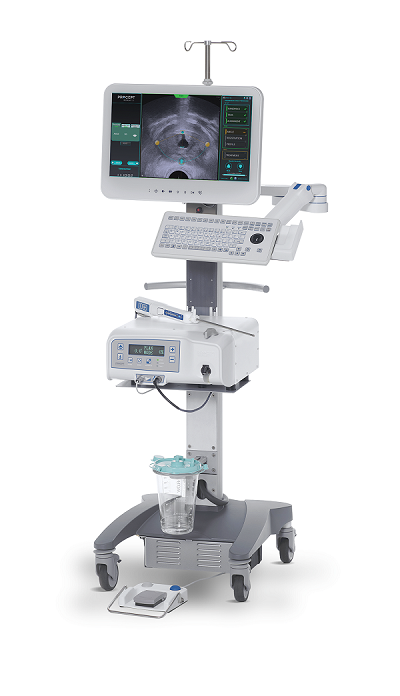Aquablation Therapy Surgical Treatment for BPH (enlarged prostate)
 Aquablation therapy is used to treat benign prostatic hyperplasia (BPH) otherwise known as an enlarged prostate. This minimally invasive robotic procedure results in standardized outcomes for long-term BPH relief and is available for patients suffering from lower urinary tract symptoms due to BPH.
Aquablation therapy is used to treat benign prostatic hyperplasia (BPH) otherwise known as an enlarged prostate. This minimally invasive robotic procedure results in standardized outcomes for long-term BPH relief and is available for patients suffering from lower urinary tract symptoms due to BPH.
How does Aquablation Therapy work?
Aquablation therapy is a resective procedure, which means that the prostate tissue causing symptoms is surgically removed. No incision is made in the abdomen, as the prostate is reached through the urethra. As the name implies, this procedure uses a high-powered water jet to remove excess prostate tissue that may be causing BPH.
Aquablation therapy is performed in a hospital and is done under anesthesia. The procedure typically takes less than an hour and usually involves an overnight stay.
Learn more about Surgery at Centennial Hills Hospital
For more information about surgical care at Centennial Hills, visit our surgery page. You can read our Patient Safety page to answer any question you may have about your stay.
Is Aquablation Therapy Right For You?
Aquablation is a surgical technique, and therefore you may need to meet certain requirements to qualify for aquablation therapy. For example, you may need to meet certain age or physical requirements to be able to withstand minor surgery.
You can talk to your doctor about whether or not you might be a good candidate for Aquablation, and take the International Prostate Symptom Score (IPSS) Quiz to measure how severe your symptoms are.
Benefits of Aquablation
If you do qualify for aquablation, you might wonder – is it worth it? Depending on your symptoms, there can be several benefits for undergoing aquablation. Some include:
Minimally invasive
One of the main benefits of aquablation surgery is that it is a minimally invasive procedure. This means that it does not require any incisions or cuts, reducing the risk of infection and complications. The water jet used in the procedure is precise and targeted, minimizing damage to surrounding tissue. This also means that there is less bleeding during and after the surgery, leading to a faster recovery time.
Reduced risk of blood clots
One of the most common complications of traditional BPH surgery is the formation of blood clots in the bladder. These clots can cause pain, difficulty urinating, and even require additional surgery to remove. However, with aquablation surgery, the risk of blood clots is significantly reduced. The water jet used in the procedure flushes out any debris or blood clots, reducing the chances of post-surgery complications.
Shorter hospital stay
Due to its minimally invasive nature, aquablation surgery typically requires a shorter hospital stay compared to traditional BPH surgery. Most patients are able to go home the same day or the next day after the procedure. This not only reduces the cost of hospitalization but also allows patients to recover in the comfort of their own home.
Aquablation Recovery
As with most BPH procedures, you will wake up with a catheter. Patients typically stay overnight in the hospital. We may send you home with a catheter for a few days or may keep you an additional night in the hospital if you are unable to pee on your own or empty your bladder at the time of discharge.
We know that no one likes staying overnight in a hospital. However, the benefit with Aquablation therapy is that most patients end up leaving the hospital without a catheter.
Once you are home, you may experience mild burning during urination for a couple of weeks. This can be managed with mild pain medication.
Individual results may vary. There are risks associated with any surgical procedure. Talk with your doctor about these risks to find out if minimally invasive surgery is right for you.
